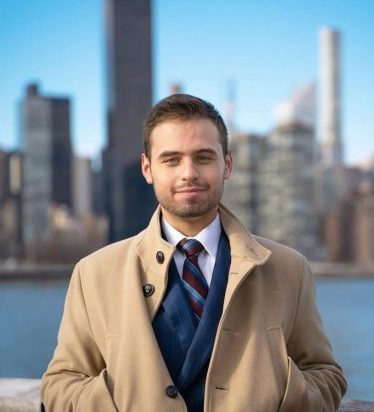Cristian Pineda’s Journey to Inclusive Web Design

For as long as he can remember, Cristian Pineda has been doing freelance work — specifically, graphic design for various businesses including photography studios, e-commerce stores, and real estate companies.
Naturally drawn to the design world, Cristian first cultivated his passion while attending a vocational high school in Queens, NY. The graphic design skills he learned there were the perfect segue into marketing and website-building.
After high school, Cristian worked in the real estate industry as a salesperson, though his responsibilities included creating landing pages for properties and compelling video content for social media. When the pandemic arrived and the real estate market plunged, Cristian was eager to explore new opportunities — and was certain he wanted to keep building web experiences.
When a family member recommended that he enroll in the Columbia Engineering UX/UI Boot Camp, Cristian was immediately sold.
Deciding between part-time and full-time
Cristian enrolled in the boot camp with confidence and positivity, despite being unemployed at the time. He decided to fully devote himself to learning rather than dwell on the challenges of the pandemic.
The part-time program, spread out over six months, would give him adequate time to absorb new information and internalize skills. “I knew a shorter program would be very fast-paced, and I might not be able to synthesize everything. So I decided to maximize the experience and take my time learning,” he explained.
Understanding web design from a new, inclusive angle
This decision proved ideal for Cristian, considering the part-time boot camp still covered material at an accelerated pace. Yet, the most beneficial part of the boot camp was not necessarily the technical information he learned, but rather a refreshing approach to design thinking and strategy.
“I really like coming up with ideas and turning them into something functional for users. But I didn’t know how to do it using a systematic, user-driven approach, until I attended the boot camp — particularly how to turn ideas into accessible, inclusive design solutions that everyone can use,” he said.
In his experience in the real estate industry, fair housing had been a big part of his job. “Discrimination is everywhere, including the world of technology. It’s important not to overlook that as a designer,” he explained.
His instructor at the boot camp, David, drove this idea home repeatedly to ensure that Cristian and the rest of his cohort were equipped with an inclusive framework for thinking in the professional world.
Entering a challenging job market
After the boot camp’s completion, Cristian committed to his job search in the same way he had with his coursework.
“I was sending out ten to twenty applications a day. I kept track of everything using an application called Hunter that my career advisor shared with me,” he explained.
This tool allowed him to easily access applications, view responses from employers, and watch his progress in the interview process. This insight from his career advisor helped Cristian land two exciting offers in the world of UX design.
Cristian ultimately joined the accounting firm, Ernst and Young, as a UX designer — and he credits the boot camp for helping him get there. “The boot camp was a tremendous learning opportunity and a great way to get my foot in the door to a new career. I learned the different methodologies and tools that are needed in modern UX design, and I’m using them every day,” he said.
Looking to advance your current career or transition to a new industry? Consider the Columbia Engineering Boot Camps in coding, data analytics, cybersecurity, fintech, digital marketing, UX/UI, tech project management, and product management.

 Live Chat
Live Chat